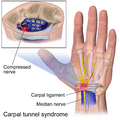Carpal tunnel syndrome facts for kids
Carpal Tunnel Syndrome (CTS) is a common condition that affects your hand and wrist. It happens when a main nerve in your wrist, called the median nerve, gets squeezed. This can cause pain, numbness, and tingling in your hand and fingers. It's like a tiny tunnel in your wrist gets too crowded!
Contents
What is the Carpal Tunnel?
Your wrist has a narrow passageway called the carpal tunnel. This tunnel is made of bones and a strong ligament. It protects your median nerve and nine tendons. These tendons help you bend your fingers. The median nerve controls feeling in your thumb, index, middle, and half of your ring finger. It also helps move some thumb muscles.
What Causes Carpal Tunnel Syndrome?
CTS happens when the median nerve in your wrist gets squeezed. This pressure can come from swelling or anything that makes the tunnel smaller. Common causes include:
- Repetitive motions: Doing the same hand or wrist movements over and over. This can be from typing, using tools, or playing certain sports.
- Wrist position: Keeping your wrist bent for long periods.
- Injuries: A wrist sprain or fracture can cause swelling.
- Health conditions: Some conditions, like diabetes or thyroid problems, can increase your risk.
- Pregnancy: Hormonal changes during pregnancy can cause swelling.
What are the Symptoms?
Symptoms of Carpal Tunnel Syndrome usually start slowly. They often appear in your thumb, index, middle, and half of your ring finger. Common symptoms include:
- Numbness: Your fingers might feel "asleep."
- Tingling: A "pins and needles" feeling.
- Pain: Aching or burning in your hand, wrist, or even up your arm.
- Weakness: You might drop things or have trouble gripping.
- Night symptoms: Symptoms often get worse at night. You might wake up needing to shake your hand.
- Loss of feeling: In severe cases, you might lose feeling in your fingertips.
How is it Diagnosed?
A doctor will usually ask about your symptoms and medical history. They will also do a physical exam. This exam might include:
- Tinel's sign: The doctor taps on your median nerve at the wrist. If you feel tingling, it might be CTS.
- Phalen's maneuver: You hold your wrists bent down for about a minute. If tingling or numbness starts, it suggests CTS.
- Nerve tests: Sometimes, special tests measure how well your nerves are working. These are called nerve conduction studies. They help confirm the diagnosis.
How is it Treated?
Treatment for Carpal Tunnel Syndrome depends on how severe it is. The goal is to reduce pressure on the median nerve.
Non-Surgical Treatments
Many people find relief without surgery.
- Rest: Taking breaks from activities that make symptoms worse.
- Splinting: Wearing a thumb|A rigid splint can keep the wrist straight or brace, especially at night. This keeps your wrist straight.
- Ice packs: Applying ice to reduce swelling.
- Medication: Over-the-counter pain relievers can help. Sometimes, doctors might suggest stronger medicines.
- Exercises: Gentle stretching and strengthening exercises for the hand and wrist.
- Injections: A doctor might inject medicine into the carpal tunnel to reduce swelling.
Surgical Treatment
If non-surgical treatments don't work, surgery might be an option.
- Carpal tunnel release surgery: This operation cuts the ligament that forms the roof of the carpal tunnel. This makes more space for the median nerve.
- Recovery: After surgery, it takes time for the hand to heal. Physical therapy might be needed to regain strength.
Can You Prevent It?
You can take steps to help prevent Carpal Tunnel Syndrome, especially if you do repetitive hand movements.
- Take breaks: Rest your hands often during repetitive tasks.
- Stretch: Do gentle hand and wrist stretches regularly.
- Ergonomics: Make sure your workspace is set up correctly. Keep your wrists straight when typing or using a mouse.
- Posture: Good posture can help reduce pressure on your nerves.
- Listen to your body: If you feel pain or tingling, stop the activity and rest.
Images for kids
See also
 In Spanish: Síndrome del túnel carpiano para niños
In Spanish: Síndrome del túnel carpiano para niños





